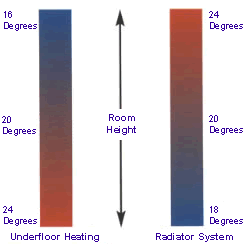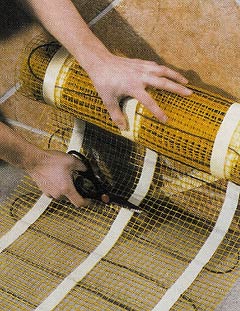Underfloor heating is a very efficient way of heating the rooms of a house. It is relatively cheap to install, there are no radiators or heaters on show, there is no maintenance, and the heat is distributed evenly around the rooms. Underfloor heating is very easy to install in a new build property, but it can be difficult (and therefore expensive) to retrofit in an existing property.
With a typical domestic network of radiators, most of the energy is wasted heating the room at ceiling height. By the time that expensively warmed air descends back into the living space, it has already lost a lot heat and it causes draughts. Underfloor heating warms the air just above the floor and that warm air then rises through the living space cooling as it rises. Very little energy is therefore wasted and rooms are heated to make them more comfortable – warm feet and a cooler head rather than cold feet and a hot head.

Underfloor heating systems are either warm water or electrical. With warm water systems, water is heated (ideally using a geothermal heat pump) and pumped around a network of thin tubes under the flooring. Electric under floor heating has a low power heating element fitted into tubes which are again fitted under the flooring. While underfloor heating may be new to you, this kind of central heating was actually invented by the Romans to heat their baths: The Hypocaust
Underfloor heating is most commonly used in bathrooms, conservatories, and kitchens – the rooms of the house which are typically tiled, and where radiators would take up valuable space. However underfloor heating can be used throughout a home including bedrooms and living spaces, and it can be covered with wooden or laminate flooring. Note that efficiency is reduced if underfloor heating is used under a fitted carpet.
One thing that must be considered before installing an underfloor heating system is insulation. It is important to insulate your home well in order to save energy and money on your heating bills – however, this is particulary important with underfloor heating systems.
As underfloor heating is mostly radiant heat, little of it will escape through walls and ceilings. But, if the floor underneath the underfloor heating is not well insulated, then there will be a lot of downward heat loss into the ground. The better your home is insulated, and in particular the ground on which the floor is fitted, the better the under floor heating system will perform for you.
